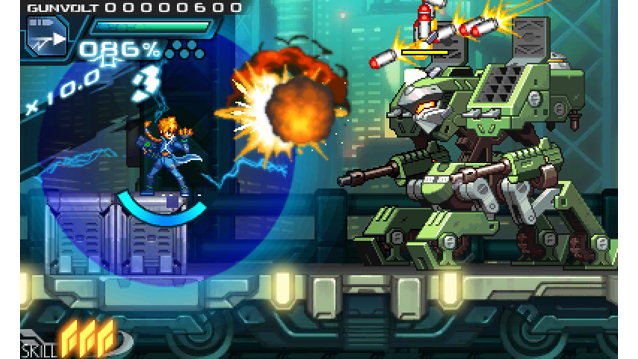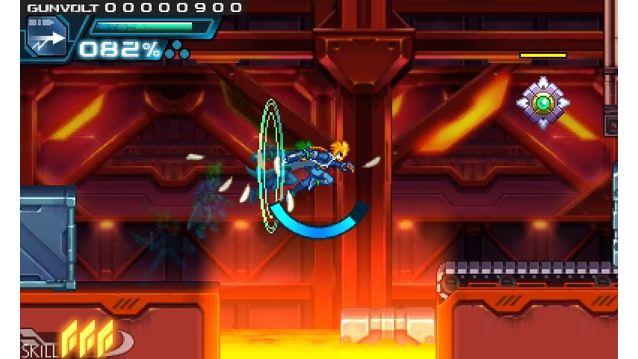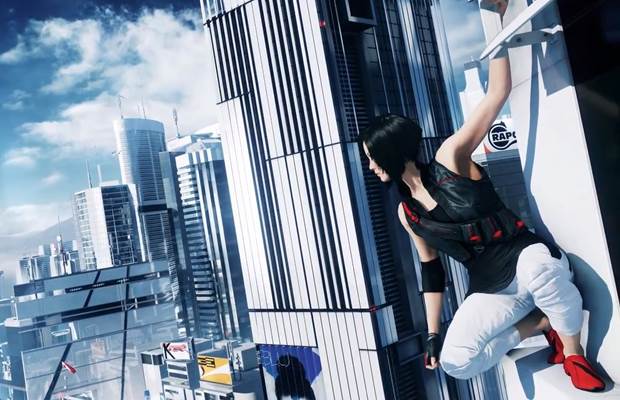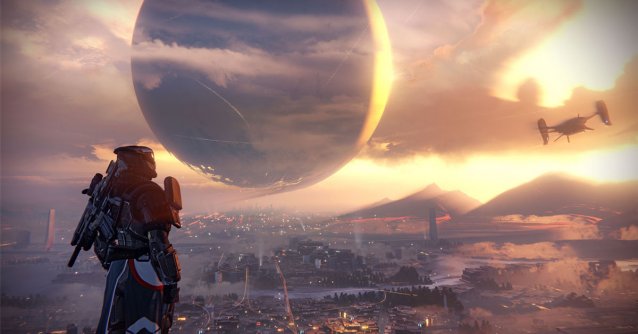


Inti Creates has earned the reputation of being the premier Mega Man developer of the 21st century, thanks to its stellar work on the Mega Man Zero series on Game Boy Advance, the Mega Man ZX series on DS, and Mega Man 9 and 10 on Wii, PlayStation 3, and Xbox 360. Inti Creates has since teamed back up with former Mega Man producer Keiji Inafune for Mighty No. 9, the Kickstarted dream project that draws more than a healthy bit of inspiration from the Blue Bomber's classic exploits. But even as work continues on Mighty No. 9, the team spared a few moments to crank out yet another Mega Man-flavored adventure: Azure Striker Gunvolt.
Azure Striker Gunvolt is a 2D action platformer that sports a pixel style reminiscent of the distinctive look employed in the Zero and ZX games. That means highly detailed sprites with buttery smooth animations, headlined by Inti Creates' knack for colorful but outrageous character designs. Allies and foes alike are draped in clothing featuring sharp lines and angles, while battle armor is decorated with fluorescent panels and deadly meter-long protrusions. As mesmerizing as that all sounds in text, the reality is much better in motion.
But even though it may look like a Mega Man game, it plays quite differently. Yes, you do select which superpowered boss you'd like to tackle from a stage select menu, but once inside a level, you aren't simply running and gunning. You control the titular Gunvolt, a teenager with electrokinesis, and he's equipped with a pistol, although the damage it deals enemies is pathetically minimal. Instead, the shots fired from your gun will "tag" the target, and by activating your Flashfield ability, you'll automatically electrocute any foe or object that has been tagged.

You can tag multiple targets at once or stack tags atop a single target for increased Flashfield damage. You run the risk of overheating while Flashfield is activated, so you have to monitor your EP gauge to make sure it doesn't fall below zero. If it does, you'll temporarily be powerless while EP refills. When Flashfield isn't activated, you'll automatically nullify incoming attacks at the cost of EP points. Conversely, once in attack mode, you are completely vulnerable to physical contact and energy projectiles, although physical projectiles like missiles will be destroyed by the Flashfield.
This offense-defense balancing act plays into Gunvolt's rather strict combo system. Defeating multiple enemies at once or performing other deft maneuvers will award you with additional points that help build a score multiplier. Getting hit regardless of whether you're in a vulnerable or invulnerable state will reset the multiplier, and when that happens, you'll lose all your accumulated points as well. You'll only be able to bank those points by reaching a checkpoint or activating one of your special skills, both which will then reset the multiplier. The longer you hold out for that high score, the greater the risk of losing all that hard work.
Many players wouldn't want to subject themselve to such harsh parameters, and that's fine. Shooting for a high score and subsequently a better grade at the end of a level is an additional challenge for those who seek it. If you wish to test your abilities even further, you can attempt special challenges such as beating a level without getting hit, collecting a certain amount of money, or clearing a stage under a time limit. There's is no penalty for failing these challenges, but beating them will award you with money and materials to be spent in the item shop.

You can customize Gunvolt's loadout before a stage, equipping him with gear that bestows stat boosts or additional abilities. You acquire most of these new tools by synthesizing them in the shop. Unfortunately, though you can choose what items to create, the availability of certain materials is left mostly to chance. Materials aren't collected during stages but upon stage completion, where you randomly choose from a number of mystery boxes. You might score big, but usually you'll get duplicates of the more common junk.
Most of the gear you can forge would be of great assistance in tackling the harder challenges, but you'll need a lot of luck just to get the specific materials needed for their creation. You could always tackle the challenges directly, as the rewards for victory are explicitly listed, but if you could complete those challenges successfully, you wouldn't be in need of new gear in the first place.
Getting back to the main campaign, the level design is every bit as varied as in Inti Creates' previous action titles. One particular highlight is a stage populated by accelerators that bounce you around the area like springs from Sonic the Hedgehog. In another stage, you must navigate a pitch dark facility in search of light panels, using your Flashfield sparingly for limited visibility. And then there are the bosses who also wield outrageous psychic powers, from a guy who opens up wormholes to attack you from multiple angles in a single strike to another who transforms the entire screen into a bullet hell maze straight out of a CAVE shoot 'em up.

The biggest issue with Gunvolt, at least in the beginning, is that the combat seemingly kills all forward momentum. The act of tagging enemies then triggering a separate technique in order to actually deal damage is such a foreign concept in this kind of high-octane action game that many players are likely to get into a cycle of starting and stopping, much like how a student driver will rapidly alternate between the gas and brake pedals. It might take longer than usual to grow acclimated to this system; it may not even click properly for many players period.
Even if you do take to the game's strict demands, Gunvolt still lacks the simpler ease of its spiritual predecessors. That doesn't make it a poor game by any stretch, simply one that's harder to recommend for all but the most die-hard action aficionados.
There is one additional bonus that may make the game more palatable to the masses: a separate title called Mighty Gunvolt, available for free to anyone who purchases Azure Striker Gunvolt within three months from launch. It's a retro demake comparable to the "Mega Man a" minigame from Mega Man ZX Advent, and at only five levels in length, it's a breezy piece of companion software that can be cleared during a typical lunch break.

Mighty Gunvolt again puts you in the shoes of Gunvolt, who arrives with a much simpler set of skills that are mapped to two face buttons and a D-pad. But you also have the option to play as the robot Beck from the upcoming Mighty No. 9 or the angel Ekoro from the Japan-exclusive rail shooter Gal*Gun. Each have their own set of abilities -- Gunvolt can double jump and launch a limited-range electricity whip, Beck can slide and perform a mid-air dash, and Ekoro can hover and recruit enemies to fight alongside her.
You visit the same locales and battle many of the same foes from the Gunvolt, albeit in reduced NES-style roles. The exception is a high school level pulled right out of Gal*Gun -- there are also plans for additional DLC levels, possibly related to Mighty No. 9. All you do is shoot through easily dispatched enemies then take down the boss. There is a combo system that involves picking up pieces of fruit scattered throughout, but since getting a high score doesn't translate into any kind of bonus, it's rather pointless. Neither do you receive any special gift in the main game for clearing Mighty Gunvolt. It's simply an extra treat.
Azure Striker Gunvolt is a challenging, sometimes brutal adventure that takes cues from the Mega Man Zero series while giving combat a wild new spin. It won't spark everybody's pleasure center, but those who continue to plug away will be properly rewarded. The addition of Mighty Gunvolt only adds to its value.
7.5 out of 10
Azure Striker Gunvolt and Mighty Gunvolt were developed and published by Inti Creates. Azure Striker Gunvolt will be available on 3DS for $14.99 starting August 29, 2014. Mighty Gunvolt will be available on 3DS for free with the purchase of Azure Striker Gunvolt between August 29, 2014, and 9:00 AM Pacific on November 28, 2014. Copies of both games were provided by the publisher for the purpose of this review.



